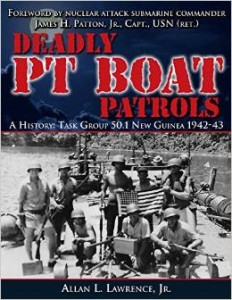Deadly PT Boat Patrols–a brief review/recommendation
[by J. Scott Shipman]
Deadly PT Boat Patrols, A History of Task Group 50.1 New Guinea 1942-43, by Allan L. Lawrence, Jr.
Late last fall a good friend suggested that I read Mr. Lawrence’s book. My friend made the connection, and Mr. Lawrence was kind enough to send an autographed copy. I read Deadly PT Boat Patrols over the Christmas break and wanted to share the title with our readers. The book is about his dad and namesake serving in the South Pacific on Motor Torpedo Boats during WWII, but really what Mr. Lawrence has crafted is a richly detailed day-by-day history of not only his father’s service, but the service of his colleagues. And when I say day by day, I mean Lawrence provides the reader with a running diary of Task Group 50.1—how they were formed and made their way to New Guinea.
Mr. Lawrence didn’t set out to write a Task Group history, however. He writes
Originally, this project was intended to be simply a photographic essay focused solely upon the Colt 1911A1 Automatic Pistol used by my father while assigned to Motor Torpedo Division SEVENTEEN in enemy waters off New Guinea. It was intended for submission to be a renowned historical pistol collectors association for inclusion, if found worthy, in their quarterly magazine. As the project unfolded, however, it became apparent that there was sufficient material of an historical nature to expand upon the original theme.
And “expand” Mr. Lawrence has done! Filled with many never before published photographs (many provided by the participants or their families) of both the men and their machines , but also of native populations, Deadly PT Boats offers the reader real insight (often in the words of the participant’s war diaries) into the struggles, dangers, and deprivations suffered and endured by the men who crewed these small fast boats. The book also has some hilarious recollections of these Sailors on liberty and the fun they had together in the midst of a brutal war.
The elder Mr. Lawrence is offered in his own words:
I like to talk about these things to anybody that is interested but you don’t find people that are interested in that kind of stuff. They’re more interested in running around with veterans plates on their cars, ya know?…I never had a dogtag—never was issued a dogtag—they said we were moving too fast. (pages 180-181)
Mr. Lawrence continued on the carnage of PT boat warfare:
It was really a nasty business—a mess, really, but those bastards were vicious, really vicious. And you couldn’t take them as prisoners. [Significant pause] Invariably you’d wind up with two or three dead bodies with their leather harnesses, their knapsacks and canvas all in the screws so you’d screw yourself up because you’d stall your engines out…So you’d come back on one engine the next day cutting the body parts and harness and stuff out from up between the screws and struts, ya know—diving down.” (page 182)
If there is a weakness in Deadly PT Boats it would be the sometimes painful level of detail and the need for a good editorial scrub, but the book is a labor of love, and if read with this in mind Mr. Lawrence takes the reader along side these young men and their lives of frustration and boredom interrupted by moments of sheer terror.
Mr. Lawrence brings the reader full circle and provides a “where are they now” or how the main characters ended up after the war. All in all, a good read.
Aficionados of WWII naval history should add Deadly PT Boats to their library as valuable contribution to the genre.
Strongly recommended.



